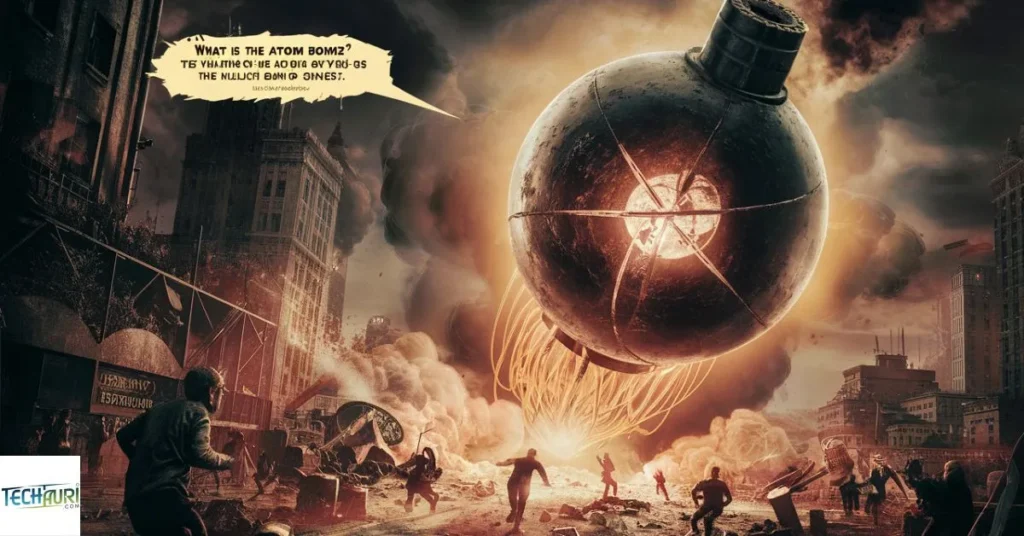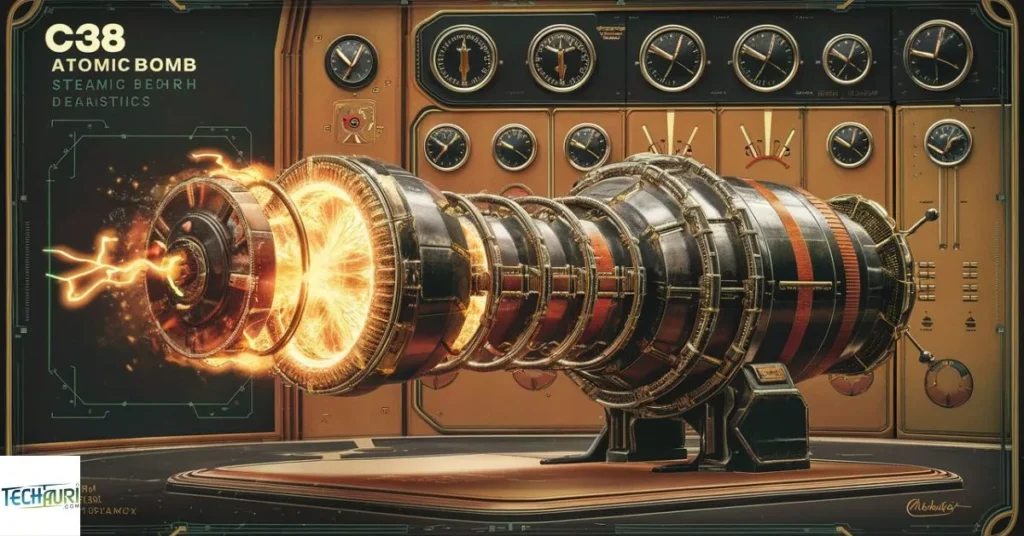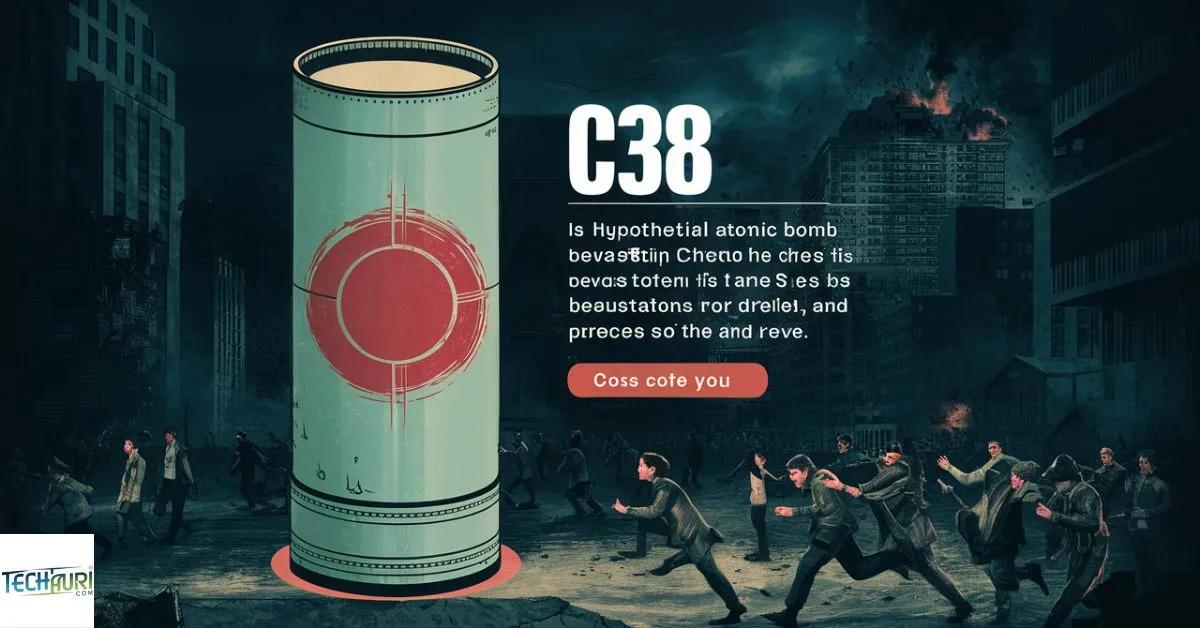Welcome to the research of the C38 Atomic Bomb, a important chapter in the date of human history. At its core the C38 is a commitment to humanity’s ingenuity and capacity for both innovation and destruction.
Developed during World War II under the shroud of the Manhattan Project this weapon represents a harmony of scientific brilliance and wartime need. The C38 Atomic Bomb derives its much more power from the manipulation of atomic nuclei specifically through the processes of nuclear fission and fusion reactions.
This great device, encased within layers of high gunpowder is designed to unleash cataclysmic energy with unparalleled force. Join us as we unravel the secrets behind this iconic weapon delving into its origin’s technical intricacies and enduring impact on our world. Through this exploration we aim to shed light on the deep significance of the C38 Atomic Bomb in shaping the course of human history.
What’s the Atom Bomb?
Let’s delve into the intricacies of the Atom Bomb. Its core Atom Bomb stands as one of consequential developments in human history forever altering the trajectory warfare and shaping the geopolitical landscape of the 20th century.

This iconic weapon obviously the pinnacle of scientific success and the darkest depths of human conflict. Developed during World War II as part of the Manhattan Project, the Atom Bomb harnesses the unthinkable power fission to unleash destractive energy on an unparalleled scale.
Join as we unravel the complexities of this historic weapon exploring its development deployment and the enduring legacy it has left on our world. Through this research we aim to shed light on the profound implications Bomb both for humanity’s scientific progress and its moral conscience.
Origins of the C38 Atomic Bomb
Let’s dive into beginning of C38 Atomic Bomb. The story of unfolds during the tumultuous years of World War II time when of the world was engulfed conflict. In early 1940s, amidst the chaos of war group of brilliant scientists and of engineers converged under the banner of Manhattan Project.
Led by visionaries like J. Robert Oppenheimer of Enrico Fermi their mission was to unlock immense power of nuclear fission for military ends. Driven by the urgency of war effort these dedicated individuals laboured overcoming countless obstacles to realize their ambitious goal.
Their collective efforts culminated in the creation of C38 Atomic Bomb a technical marvel that would forever alter course history. Join us as we journey back in time to explore the fascinating origins of this iconic weapon uncovering the scientific breakthroughs human dramas and ethical dilemmas that defined inception.
The Technical specs of the C38 Atomic Bomb
Let’s delve into technical specifications of the C38 Atomic Bomb. At core this iconic weapon represents a remarkable fusion of cutting-edge technology and scientific ingenuity. Designed during height of World War II as part of Manhattan Project.


The C38 harnesses the power of the nuclear fission and fusion reactions to the unleash devastating energy on unprecedented scale. The bomb comprises a fissile core typically enriched uranium-235 or plutonium-239 encased within layers of high explosives and essential components for detonation.
The explosive power of C38 is generated through a two-stage process involving both nuclear fission and fusion reactions. This intricate design allows the bomb to achieve a yield measured in kilotons or megatons of TNT equivale.
Its making it one of most formidable weapons ever created. Join us as we explor technical intricacies of the C38 Atomic Bomb. Unravelling the mysteries behind design composition and destructive power.
Design And Composition
The design and composition of the C38 Atomic Bomb. At core this weapon represents feat of engineering ingenuity and scientific innovation. Developed during World War II as part of Manhattan Project the C38 is meticulously crafted.

To harness the immense power of nuclear fission and fusion reactions. Its design comprises a sophisticated arrangement of components including a fissile. Core typically enriched uranium-235 or plutonium-239, surrounded by layers of high explosives and specialized materials essential for detonation.
The composition of the bomb is carefully calibrated to facilitate a controlled chain reaction. Unleashing a of devastating explosion with unparalleled force. Join us we unravel the complexities of design and composition of the C38. Atomic Bomb exploring the scientific principles and engineering marvels that underpin its formidable capabilities.
Fission and Fusion Reactions
Its unravel the intricacies of fission and fusion reactions within context of C38 Atomic Bomb. These reactions lie at the heart of the bomb’s devastating power. Within the bomb’s core process of nuclear fission is initiated by traditional explosives.
which the compress fissile material such as the uranium-235 or plutonium-239. This fission reaction releases of an immense amount the energy and an additional neutron triggering a cascading chain reaction as more atoms split. A secondary stage the fusion reactions occurs where isotopes of hydrogen undergo fusion liberating even more energy.
This two-stage process unleashes an the unprecedented explosion measured in kilotons or megatons of the TNT equivalent. Join us we delve deeper into a science behind fission and fusion reactions unlocking the secrets of the C38 Atomic Bomb’s formidable destructive force.
Yield and Explosive stress
Its explore the concepts of yield and explosive the stress as they relate to C38 Atomic Bomb. These factors are crucial in understanding the destructive potential this iconic weapon. The yield of bomb refers to amount of energy released. During the explosion typically measured in kilotons or megatons of the TNT equivalent.
It serves as gauge of bomb’s destructive power of reflecting the magnitude of devastation it can inflict. The explosive stress on the other hand encompasses the force exerted by the explosion which can cause structural damage create blast waves and induce widespread destruction.
Together yield and explosive stress paint a vivid picture of C38’s formidable capabilities highlighting. The immense danger to posed by this weapon of mass destruction. Join us we delve deeper into these concepts uncovering the science behind the C38 Atomic Bomb’s devastating impact.
Shipping Mechanisms
We delve into a logistics of shipping mechanisms employed for a C38 Atomic Bomb. Transporting such as powerful weapon requires meticulous of planning and execution. The C38 can be delivered through various of means including strategic a bombers ballistic missiles and artillery shells.
Each method a offers its own advantages and challenges from long-range capabilities of bombers to precision targeting of a missiles. The versatility of these shipping to mechanisms allows for strategic flexibility in deploying the C38. Ensuring that it can reach its intended targets with precision and devastating force.
Join us we explore the intricate strategies to behind the transportation of the C38 Atomic Bomb. Uncovering the logistical complexities involved in delivering such a formidable weapon of war.
Safety and protection
Safety and the protection measures surrounding the C38 Atomic Bomb are paramount. Considering its of immense destructive potential and catastrophic consequences of the any mishap. Rigorous to protocols and safeguards are in place to prevent an unauthorized access. Accidental detonation, and of proliferation to rogue entities or hostile states.

Advanced safety to mechanisms are integrated into bomb’s design to minimize the risk of unintended detonation. It delve into the comprehensive guide safety and the protection measures associated with the C38 Atomic Bomb:
| Safety Measure | Description |
| Physical Security | Robust physical barriers and access controls are implemented to prevent unauthorized entry to facilities housing the bomb. |
| Personnel Screening | Stringent background checks and security clearances are conducted for individuals involved in handling or guarding the bomb. |
| Encryption Systems | Advanced encryption technologies safeguard communication channels and prevent unauthorized access to sensitive information related to the bomb. |
| Safety Mechanisms | The bomb is equipped with sophisticated safety features to prevent accidental detonation, such as arming and firing mechanisms with multiple fail-safes. |
| Training and Drills | Regular training sessions and emergency drills are conducted to ensure personnel are proficient in handling and responding to potential safety threats. |
This robust safety and to protection measures of underscore the meticulous planning and dedication of preventing catastrophic accidents associated with the C38 Atomic Bomb
The big apple task: Racing towards Time
From delve into urgency and to intensity of Manhattan Project aptly nicknamed “The Big Apple Task.” During the World War II this to monumental undertaking was characterized by a relentless race against time. Driven by imminent threat of enemy to forces acquiring nuclear capabilities.
Scientists and the engineers from diverse backgrounds a were recruited to collaborate on this top-secret project. The working of around the clock to harness power of atomic energy before it fell into wrong hands. The urgency of wartime spurred unprecedented levels of the innovation and collaboration culminating in the success development of the C38 Atomic Bomb.
Join us we unravel the gripping narrative of “The Big Apple Task,” shedding light on remarkable achievements of and sacrifices made in pursuit of scientific advancement and national security.
The Trinity take a look at: Unleashing the power of the Atom
- Location: The Trinity Test of occurred at Alamogordo to Bombing and Gunnery Range in the New Mexico, chosen for remote location and the suitable terrain for testing atomic weapons.
- Device: Scientists detonated an implosion-type plutonium bomb during the test, resembling the design of the Fat Man bomb later dropped on Nagasaki.
- Yield: The explosive yield of the Trinity Test was approximately 20 kilotons of TNT, demonstrating the immense power of nuclear fission.
- Impact :The success of the Trinity Test validated the feasibility of atomic weapons, leading to the deployment of the C38 Atomic Bomb against Japan and shaping the course of World War II.
- Scientific Milestone: The Trinity Test marked a significant scientific achievement, providing crucial data and insights that propelled advancements in nuclear weapons technology.
The Trinity of Test epitomizes of pivotal moment in its history underscoring the dawn of atomic age and to far-reaching consequences of nuclear proliferation.
Deployment and Destruction: The Legacy of the C38
Let’s delve into the deployment and consequential aftermath of the C38 Atomic Bomb uncovering its enduring legacy on history. Following it develop and the testing of C38 was deploy with devastating effect to during World War II. On August 6, 1945, the bomb was to dropped on Japanese city of Hiroshima. Instantly to causing widespread destruction and the loss of life. Three days later for Nagasaki suffered to a similar fate.
The unparallel the devastation of wrought by these bombings to hastened Japan’s surrender and brought the end to the war. The legacy of C38 extends far beyond it immediate impact. It use raised profound moral and the ethical questions about use of nuclear weapons leading to international a efforts to prevent their proliferation and advocating for disarmament.
To horrors witnessed in Hiroshima and the Nagasaki serve as the stark reminder of catastrophic consequences of nuclear warfare urging of humanity to strive for peace and prevent such tragedies from recurring.
The Aftermath: contemplating the consequences
Reflecting on the aftermath of the C38 Atomic Bomb’s deployment unveils. A sobering landscape to devastation and the contemplation. In the wake of as bombings of Hiroshima and Nagasaki. To the world grappled with the profound moral ethical and existential consequences of nuclear warfare.
The staggering human toll and widespread destruction forced nations. To confront the terrifying reality of atomic bombs. The harrowing images of suffering and loss spurred global efforts. To prevent the spread of nuclear weapons and avert future use in conflicts.
The environmental and long-term health impacts underscored. The far-reaching effects of these weapons on generations to come. The aftermath of the C38 bombings serves as a poignant reminder. The imperative to pursue peace foster international cooperation and uphold. The sanctity of the human life in world haunted by the spectre of the nuclear annihilation.
Legacy and Lessons learned
The legacy of the C38 Atomic Bomb extends far beyond. Its technical specifications resonating deeply in the collective consciousness of humanity. Its detonation to over Hiroshima and the Nagasaki in 1945 left an to indelible mark on history. Serving as a stark reminder of catastrophic consequences of the nuclear warfare.
In the aftermath of thethese bombings of world was forced be confront. The grim realities of the atomic devastation and the grapple with moral and ethical implications of such destructive power. The haunting images of destruction and suffering sparked global outrage. And prompted concerted of efforts to prevent the spread of the nuclear weapons.
The bombings of the Hiroshima to Nagasaki underscored. The urgent to need for international cooperation of dialogue to address global security challenges. The enduring legacy oC38 Atomic Bomb serves as to poignant reminder of imperative to pursue peace. The foster diplomacy and the uphold the sanctity of human life in an increasingly complex and interconnected world.
Cold war Realities
The deterrence strategies, heightening global anxieties and shaping geopolitical dynamics. Let’s delve into the realities of the Cold War era:
| Key Aspect | Description |
| Geopolitical Rivalries | The Cold War was characterized by intense geopolitical rivalries between the United States and the Soviet Union, leading to proxy conflicts, espionage, and ideological battles for global supremacy. |
| Nuclear Arms Race | The period saw an unprecedented arms race between the superpowers, as they sought to acquire and stockpile vast arsenals of nuclear weapons as a deterrent against potential adversaries, resulting in an exponential increase in the quantity and destructive capabilities of these weapons. |
| Doctrine of Nuclear Deterrence | The doctrine of nuclear deterrence dominated strategic thinking during the Cold War, underpinning the notion that the possession of nuclear weapons would prevent conflict by ensuring mutual destruction, thereby maintaining a delicate balance of power and deterring aggression. |
The realities of Cold War underscored to precariousness of global security. The devastating potential of the nuclear conflict highlighting the imperative for diplomacy arms control and de-escalation efforts.
Takeaways
In reflection upon to the tumultuous events of Cold War to several key takeaways emerge shaping to global perceptions and of policy approaches for generations to come.

- Lessons of History: The Cold War era serves as a stark reminder of the catastrophic consequences of nuclear conflict, underscoring the imperative for diplomatic solutions and peaceful coexistence.
- Importance of Diplomacy: Diplomatic engagement and dialogue emerged as essential tools for managing tensions and resolving disputes in a nuclear-armed world.
- Need for Arms Control: The arms control agreements and treaties negotiated during the Cold War, such as the Strategic Arms Limitation Talks (SALT), highlighted the importance of multilateral efforts to reduce the proliferation of nuclear weapons and mitigate the risk of global catastrophe.
- Humanitarian Concerns: The humanitarian consequences of nuclear warfare, exemplified by the devastation of Hiroshima and Nagasaki, underscored the moral imperative to prevent the use of these weapons and pursue disarmament efforts.
- Global Cooperation: The Cold War era emphasized the necessity for international cooperation and collaboration in addressing common threats and challenges, transcending ideological divides and fostering mutual understanding.
The takeaway from Cold War era resonates deeply in the effective discussions on the global security and wonderful serving as of guiding principles for navigating the complexities of the nuclear-armed world.
FAQs
What is the strongest bomb in the world?
The strongest bomb in the world is Tsar Bomba develope by the Soviet Union with to yield of approximately 50 megatons of TNT.
What is the name of the bomb that can destroy the world?
The bomb often associated with the capability to potentially destroy the world is the Tsar Bomba developed by the Soviet Union during the Cold War. With a yield of approximately 50 megatons of TNT. It represents one of the most powerful nuclear weapons ever tested.
What was the 2 atomic bombs called?
The two atomic bombs dropped during World War II were named “Little Boy” and “Fat Man.” “Little Boy” was dropped on Hiroshima on August 6, 1945, while “Fat Man” was dropped on Nagasaki on August 9, 1945.
What is the 2nd most powerful bomb in the world?
The second most powerful bomb ever detonated is the Soviet Tsar Bomba. Which had a yield of approximately 50 megatons of TNT.
What’s an atom bomb?
An atom bomb, also known as a nuclear bomb is a powerful explosive device that derives. Its destructive force from nuclear reactions particularly nuclear fission or a combination of fusion reactions.
How does an atom bomb work?
An atom bomb works by triggering a chain reaction of nuclear fission or fusion. Releasing a massive amount of energy in the form of heat blast and radiation. This explosive force is the result of splitting or fusing atoms within the bomb’s core.
What are the consequences of an atom bomb explosion?
The consequences of an atom bomb explosion include devastating. Blast waves causing widespread destruction and casualties along with intense thermal radiation and long-term nuclear radiation leading to severe burns illness and environmental contamination.
how many atom bombs have been dropped in records?
Since the first atomic bomb test in 1945, a total of two atomic bombs have been dropped in warfare both during World War II.
Conclusion:
The development and the use of atomic bombs have left an the indelible mark on human history symbolizing. Both the pinnacle of the scientific achievement and the depths of devastation that humanity is capable of inflicting.
The bombings of the Hiroshima and Nagasaki serve as of stark reminders. The catastrophic consequences of the nuclear warfare prompting ongoing efforts to prevent the proliferation of a such weapons and promote global disarmament.
As we reflect on legacy of atomic bombs it is imperative that we continue to strive for peace. Foster international cooperatio and uphold the sanctity of human life in a world confronted by the specter of nuclear annihilation.











